How to Flip Adoor Quick and Easy When Painting
How to Paint a Door
How to paint a door: Get great results, even on panel doors.
Every editorial product is independently selected, though we may be compensated or receive an affiliate commission if you buy something through our links. Ratings and prices are accurate and items are in stock as of time of publication.
![]() Time
Time
A full day
![]() Complexity
Complexity
Intermediate
![]() Cost
Cost
$51–100
Introduction
Painting paneled doors is the ultimate painter's challenge. To make it easier, we tried different tools and paints and watched pros work. Here's what we found.
Tools Required
Materials Required
- Foam brushes
- Paint
- Paint drip remover
- Primer
- Sandable filler
- Sanding sponges
- Sandpaper
Picking your paint
While you're picking a paint color, also think about sheen. With a flat finish, scuff marks and handprints are hard to wipe away. High gloss is easy to clean but accentuates every little flaw, so your prep and paint job need to be perfect. Satin and semigloss are good compromise choices.
Note: Painting a door typically takes three to five hours, depending on the condition of the door and how fussy you are. But add in the drying time and it's a full-day project. So if you're painting a door you can't live without, like a bathroom or exterior door, start first thing in the morning so it can be back in service by day's end.
Project step-by-step (14)
Step 1
Painting Prep Tips
Pros often paint doors in place. But from prep to painting, you'll get better results if you remove the door. Working in your garage, shop or basement allows you to control lighting and drying conditions better. Laying the door flat will also minimize runs in the paint job.
Here's what to do after you remove the door:
- Clean the door with a household cleaner;
- Almost any cleaner will do, as long as it cuts grease. Areas around doorknobs are especially prone to greasy buildup.
- Remove all the door hardware to get a neater paint job and save time;
- Slice through paint buildup around hinges and latches.
- Fill dents and holes with a sandable filler such as MH Ready Patch.
- Pro tip: You'll probably have to fill deep dents twice to compensate for shrinkage.
- Remove old paint from the hardware. Start with a product intended to remove paint splatter such as Goof Off Pro Strength Remover or Goo Gone Painter's Pal.
- You can use paint strippers, but they may also remove clear coatings from the hardware or damage some types of finishes.
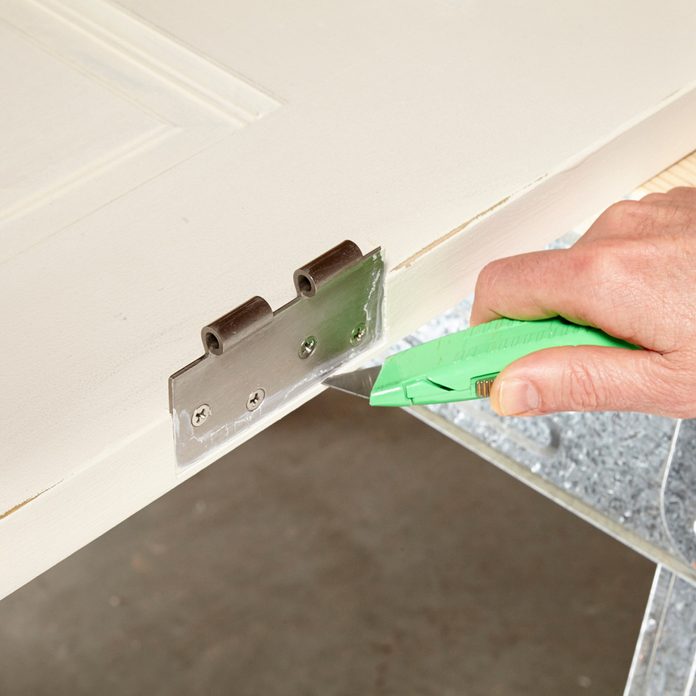
Step 2
Sand the Door Smooth
- Start with light sandpaper or a sanding sponge (180 or 220 grit). This will roughen the surface a little and allow the primer to adhere better.
- Smooth out chipped paint and imperfections from previous paint jobs.
- This is usually the most time-consuming, tedious part of the project.
- On flat areas, level out old runs and brush marks with a hard sanding block. For the shaped profiles use a combination of sanding pads, sponges and scraps of sandpaper.
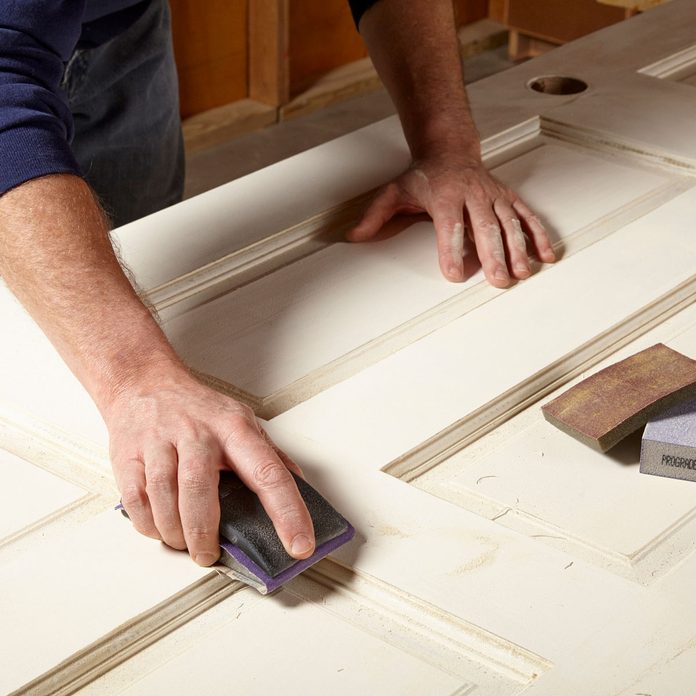
Step 3
Remove the Sanding Dust
- Paint often sticks to sandpaper, clogging the grit and making it useless;
- Pro tip: Be sure to check the label and buy sandpaper intended for paint. You may still get some clogging, but you'll get less.
- Start with 120 or 150 grit. You can switch to coarser paper (such as 80 grit) on problem areas, but be sure to follow up with finer grit to smooth out the sanding scratches.
- Pro tip: Use a finishing or random-orbit sander on flat areas. It might save you tons of time.
- Use a vacuum with a brush attachment to remove most of the dust. Wipe off the rest with a damp rag.
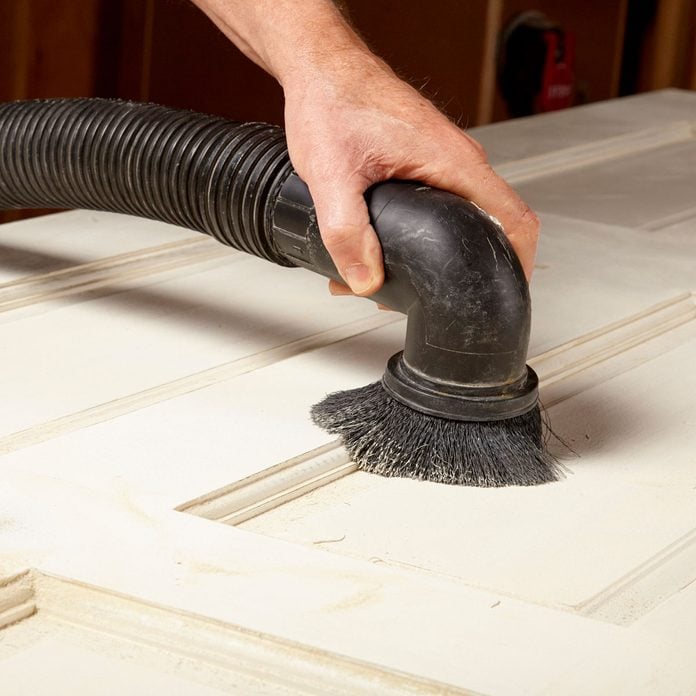
Step 4
Sand After Priming
- Sand out any imperfections in the prime coat;
- Shine a light across the surface at a low angle to accentuate imperfections;
- Mark any spots that need an extra dab of filler with masking tape.

Step 5
Paint for a Smooth Finish
- Choose a paint designed for a smooth finish;
- Pro tip: Smooth paints are usually labeled "enamel" or "door and trim."
- Super-smooth paints often cost $25 to $30 per quart! But it's worth an extra 10 bucks per door to get first-class results.
- Pro tip: Smooth paints are usually labeled "enamel" or "door and trim."
Our Door Paint Pick:
Among the paints we've used, one category stands out for smoothness: water-based alkyds.
- These paints dry slowly for extra working time and level out almost as well as traditional oil-based alkyds.
- After applying them with a high-quality roller, you can usually skip the brush-out steps and still get perfect results.
- Cleanup is as easy but be prepared for a long wait before re-coating (16 to 24 hours) and a higher price tag.

Step 6
Tips for a Perfect Workspace
After the messy job of sanding is done, set the door aside and prep your workspace.
- For priming and painting, you want a work zone that's well lit and clean.
- Pro tip: Sawdust on your workbench will end up on brushes; airborne dust will create whiskers on the paint.
- Minimize air movement for less airborne dust and slower drying. Close doors and windows. Turn off forced-air heating or cooling.
- Don't rely on overhead lighting; you may even want to turn it off.
- Pro tip: Position a work light four to five feet above the floor. This low-angle light will accentuate any drips or ridges.

Step 7
Door Painting Tricks
- Make the door flippable: Drive one screw into one end and two into the other.
- This lets you coat both sides of the door without waiting for the first side to dry.
- Wet the floor: A wet floor prevents you from kicking up dust that will create dust nubs in your finish. It also raises the humidity, which extends the time you have to smooth out the paint and gives the paint more time to level out.
- We found raising the humidity doubled the working time of the paint.
- Keep a pair of tweezers handy: Pluck out paintbrush bristles or rescue stuck insects without messing up the paint.
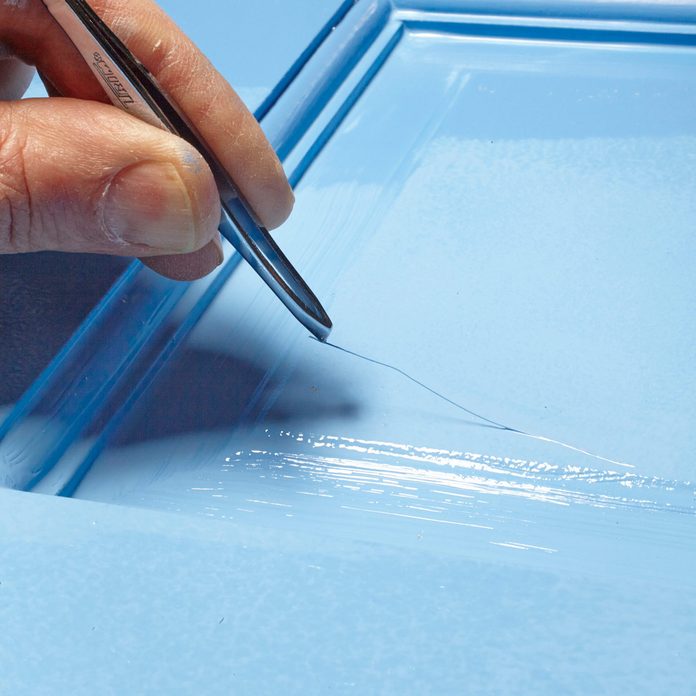
Step 8
Door Painting Priming Tips
- You can "spot-prime" a door, coating only patched dents or areas you sanded through to bare wood. But priming the whole door is best.
- Pro tip: The new paint will stick better and you'll get a more uniform finish.
- Your choice of primer is just as important as your choice of paint. At the paint store, ask for a primer that's compatible with your paint, levels out well and sands smoothly.
- Pro tip: The new paint will stick better and you'll get a more uniform finish.
- For an ultra-smooth paint job, apply two coats of primer.
- Lightly sand the primer with 220-grit, inspecting as you go.
- A couple of quick passes is all it takes.
- Let the primer dry overnight before sanding.
- The longer it dries, the better it will sand.
- Paint the edges and wipe off the slop. Brush or roll paint onto all four edges. Immediately wipe any paint that slops onto the face of the door with a rag or foam brush.

Step 9
Painting Tips
- Painting a door is a race against time.
- You have to lay down the paint and smooth it out before it becomes too sticky to work with, or so stiff that brush marks won't level out and disappear.
- Consider a paint additive to slow down drying and improve leveling.
- Start with a dust-free door; wipe it down with a damp rag just before painting.
- Don't use cheap roller sleeves or you'll get fibers in the finish.
- Use a mini roller and get good results with microfiber, mohair and foam sleeves.
- Paint all four edges of the door first.
- Pro tip: When painting edges, some paint inevitably slops onto the faces of the door. It's better to have that happen before the faces are painted.
- Brush on a light coat.
- A heavy coat of paint covers better and sometimes levels out better, but runs are more likely and brush marks are deeper.
- Roll on the paint where you can.
- Rollers lay on paint much faster than a brush, giving you a few more precious minutes to work the paint before it begins to stiffen.
- Brush out rolled paint.
- Brushed paint usually levels out better than rolled paint, and any brush marks are less noticeable than roller stipple.
- Pro tip: With top-quality enamel and roller sleeves, roller results can be super smooth.
- Brushed paint usually levels out better than rolled paint, and any brush marks are less noticeable than roller stipple.
- Plan to apply at least two coats and lightly sand between coats with 220-grit to remove any dust nubs.
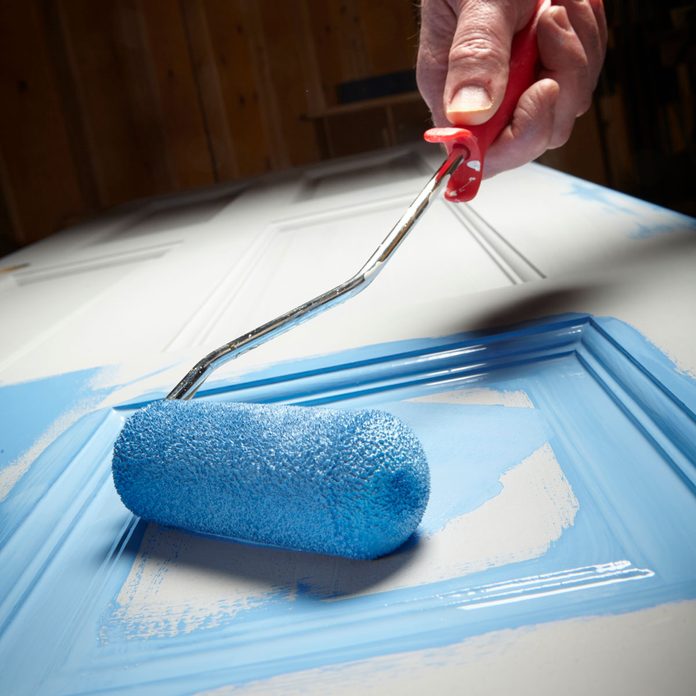
Step 10
Brush Around the Panels
- Work the paint into the corners and grooves.
- Then drag the brush over the paint to smooth it.
- Wipe away any slop around the panel.

Step 11
Roll, Then Brush the Panels
- Coat the panels quickly with a roller.
- Then smooth the paint with a brush.
- Be careful not to touch the profiles surrounding the panel.
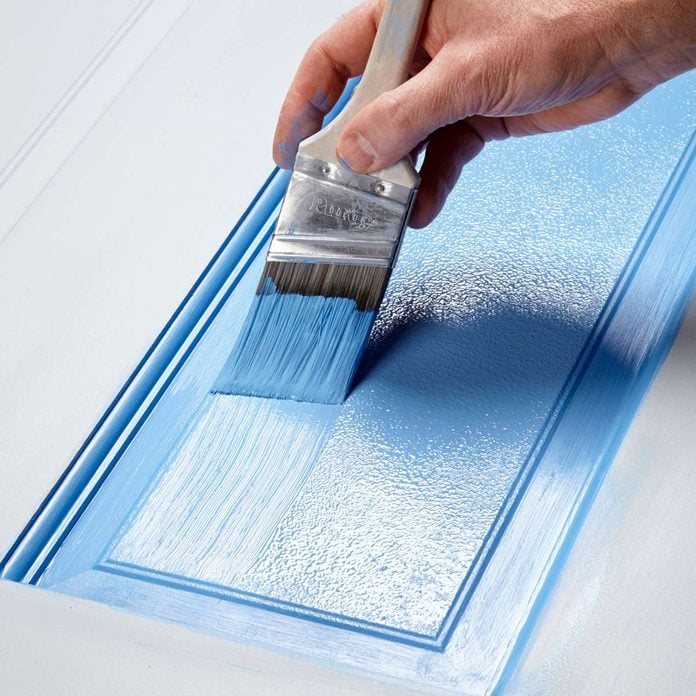
Step 12
Roll the Rails and Stiles
- Roll the door in sections, coating no more than one-quarter of the door at a time.
- Then brush out the paint.
- Be careful not to slop paint over the edges around the panels.
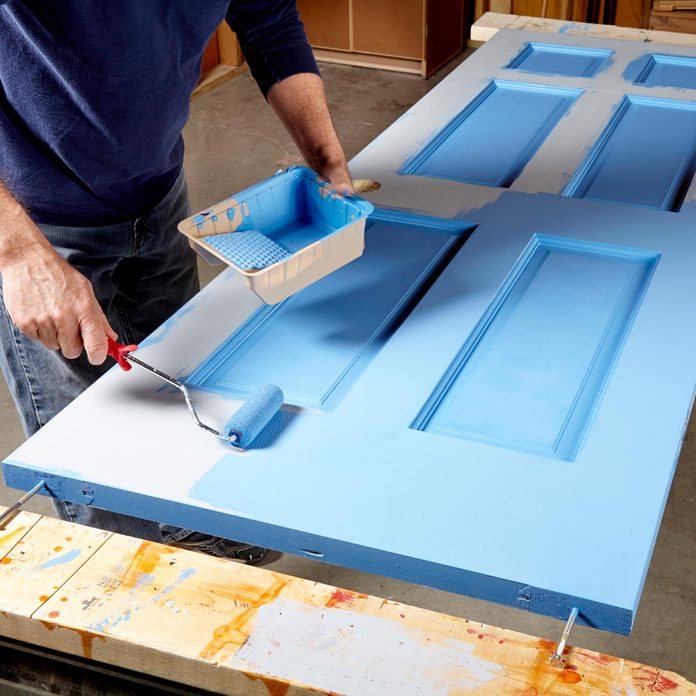
Step 13
Brush With the Grain
- Brush across the joints where door parts meet.
- Then drag your brush in a straight line along the intersection.
- Pro tip: Any visible brush marks will look more like a wood grain pattern and less like sloppy brushwork.

Step 14
The Ultimate Smooth Finish
- Even the most skilled painter can't match the perfection of a sprayed-on finish.
- There are two types of sprayers: "airless" and "HVLP" (high-volume, low-pressure).
- Both can apply a flawless coat in minutes, but HVLP is more forgiving. It produces a finer spray, which reduces your chances of blasting on too much paint and creating runs.
- There are two types of sprayers: "airless" and "HVLP" (high-volume, low-pressure).
- Aside from finish quality, a sprayer will also save you hours of brushwork if you have several doors to paint.
For more on airless and HVLP sprayers, see Paint Sprayer Reviews and Painting With an Airless Sprayer.
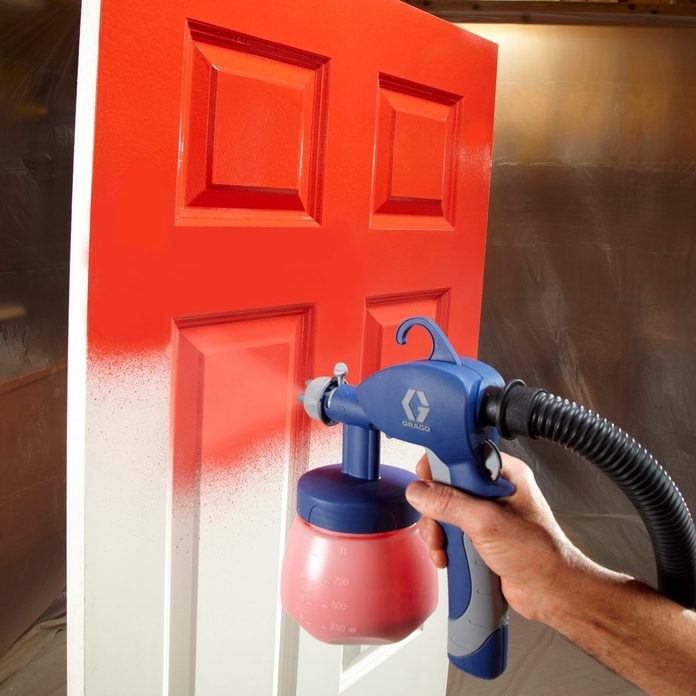
Originally Published: May 15, 2020
Source: https://www.familyhandyman.com/project/painting-doors/
0 Response to "How to Flip Adoor Quick and Easy When Painting"
Post a Comment